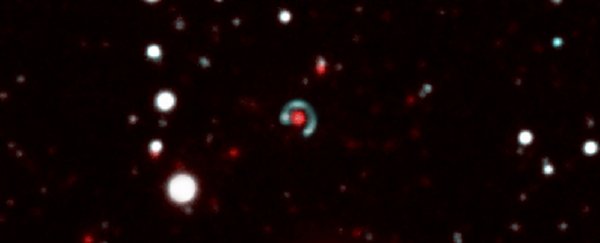Originally predicted by Einstein's theory of general relativity, an Einstein ring is one of the rarest and most exciting sights in the galaxy. It's created by two distant galaxies that are perfectly aligned, even though they're millions of light-years apart.
They're incredible anomalies in our Universe, and now an international team of astrophysicists has spotted a new one some 10,000 million light-years away.
It's been named the Canarias Einstein ring, and was discovered by chance by PhD student Margherita Bettinelli from the University of La Laguna in the Canary Islands.
While analysing a dwarf galaxy through the Dark Energy Camera (DECam) at the Cerro Tololo Observatory in Chile, Bettinelli spotted the tell-tale signs of an Einstein ring, and the phenomenon was confirmed by a separate team of researchers.
An Einstein ring occurs when a very distant galaxy (called the source) is viewed through the 'lens' of a galaxy between it and the observer (in this case, Margherita Bettinelli).
The massive galaxy in the middle bends light due to a strong gravitational field, which means that when the two galaxies are exactly aligned, a halo effect is created. The source galaxy appears as an almost perfect circle around the lens galaxy.
The Canarias Einstein ring is one of the most symmetrical examples of the phenomenon ever discovered, and is almost exactly circular – meaning the two galaxies are almost exactly aligned. The most distant galaxy is 10,000 million light-years away from Earth, and the light from it has taken 8,500 million light-years to reach us, as the galaxy would've been closer when the light began its journey through space.
The lens galaxy, on the other hand, is 6,000 million light-years away, and is more evolved than the source galaxy. We're seeing the source as it was 8,500 million light-years ago – a blue galaxy formed from young stars that are coming together at a high rate.
The astrophysicists used a spectrograph on the Gran Telescopio Canarias (GTC) at the Cerro Tololo Observatory to analyse the Einstein ring, and ended up lending the name of the telescope to their new discovery. It's currently the world's largest single-aperture optical telescope, and came fully online in 2009.
"Studying these phenomena gives us especially relevant information about the composition of the source galaxy, and also about the structure of the gravitational field and of the dark matter in the lens galaxy," said astrophysicist Antonio Aparicio from the University of La Laguna's Instituto de Astrofísica de Canarias (IAC).
While Einstein himself was pessimistic about ever finding an Einstein ring, several of varying degrees of completeness have now been discovered. We have yet to see a perfectly formed Einstein ring, but that Canarias one comes close.
The report of the discovery has been published in Monthly Notices of the Royal Astronomical Society.
